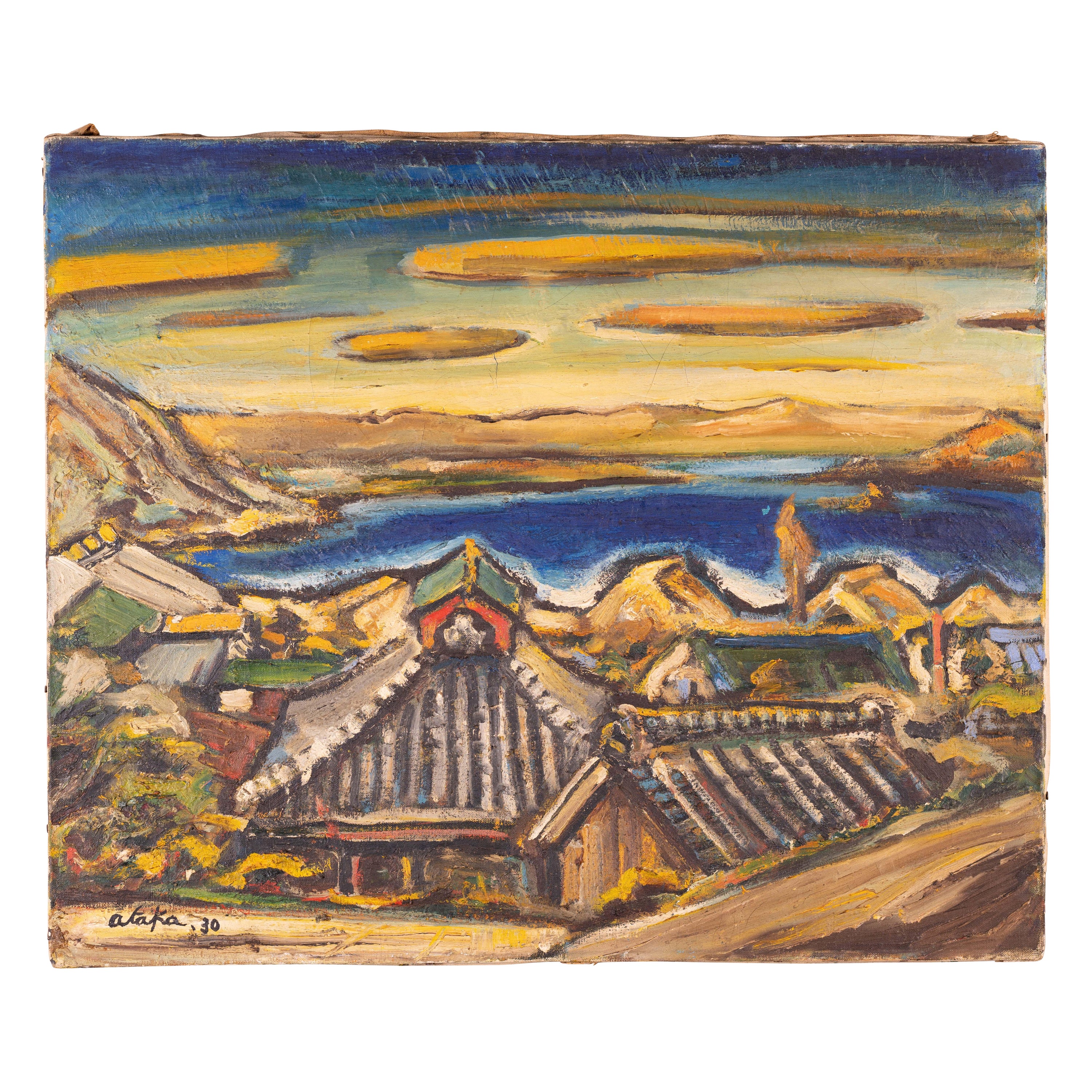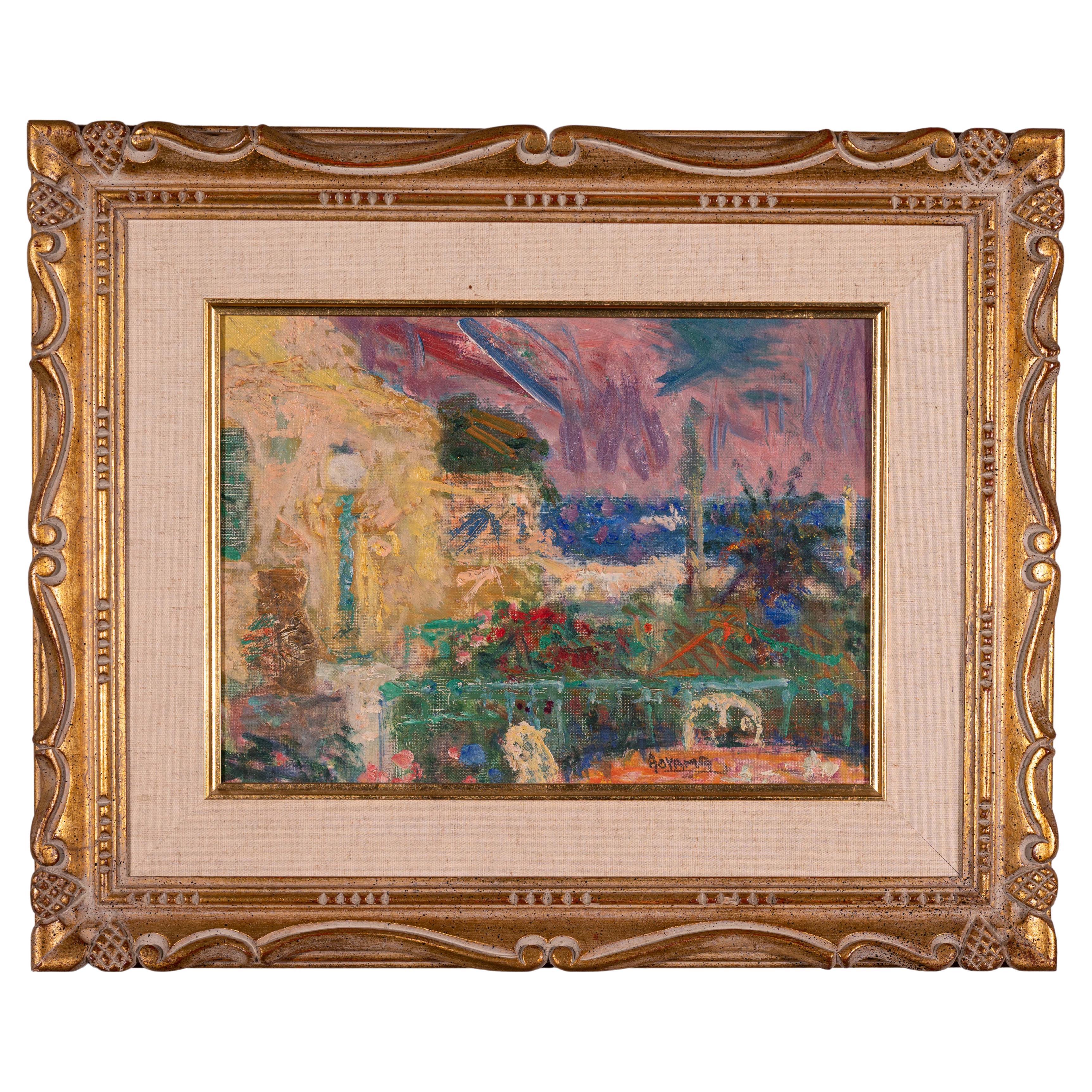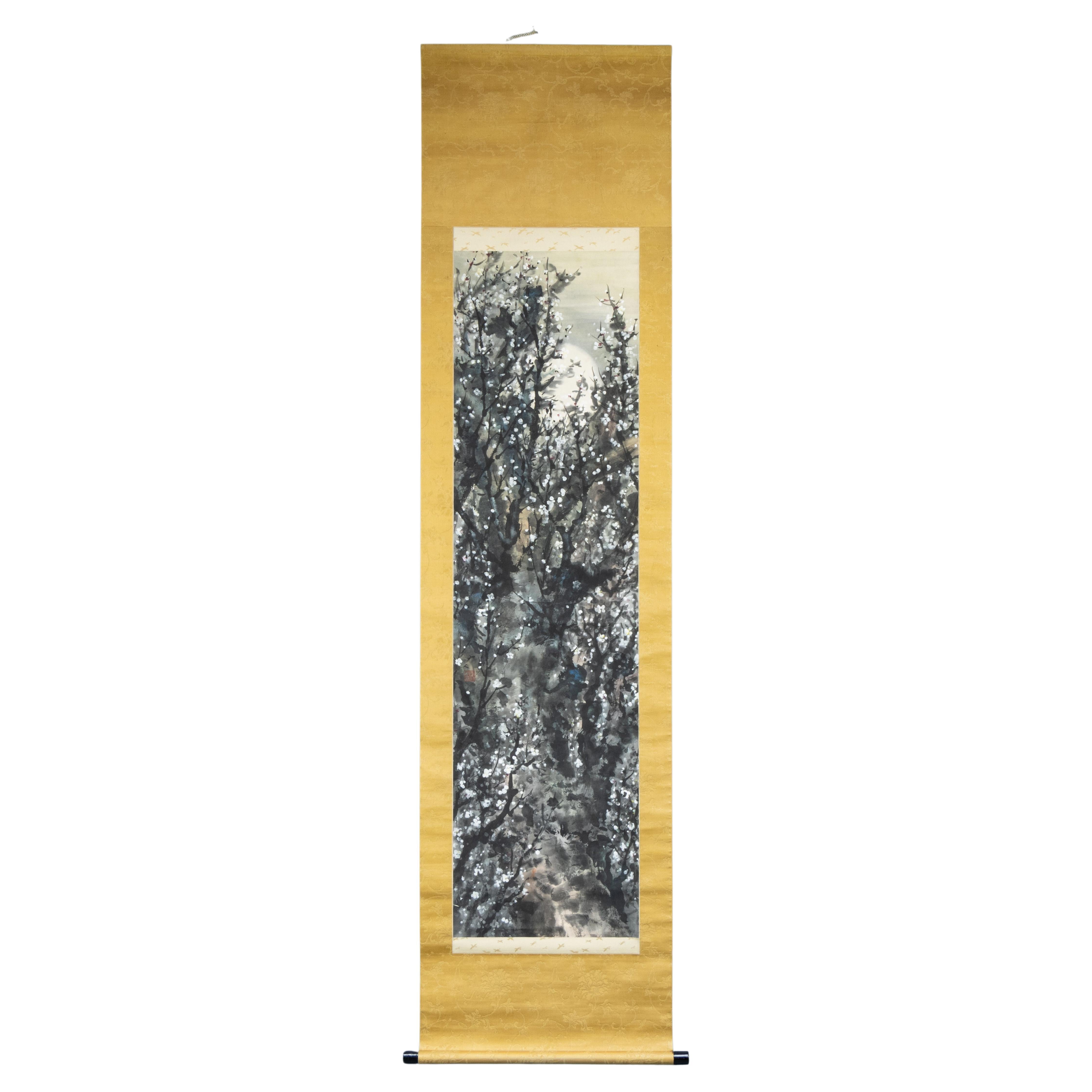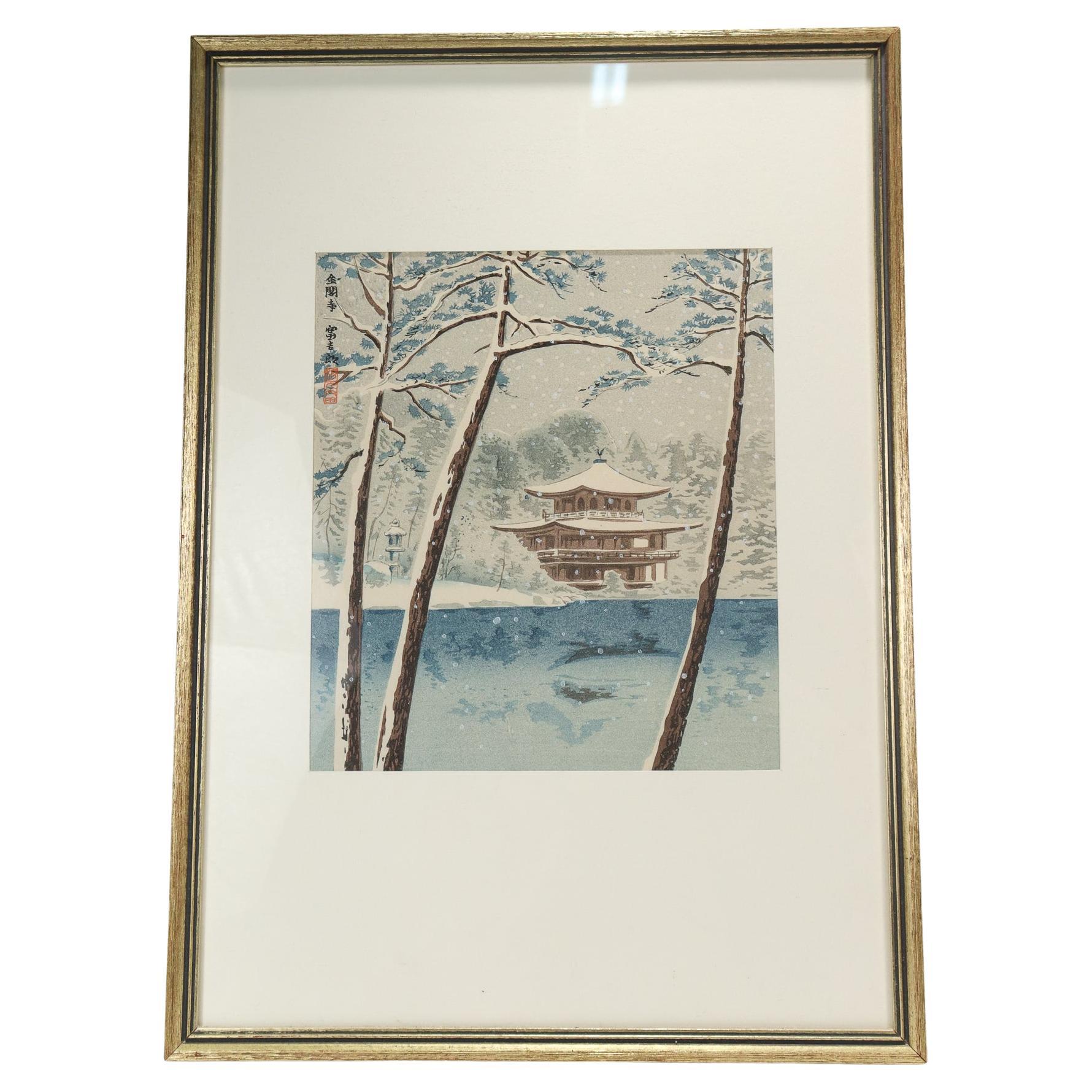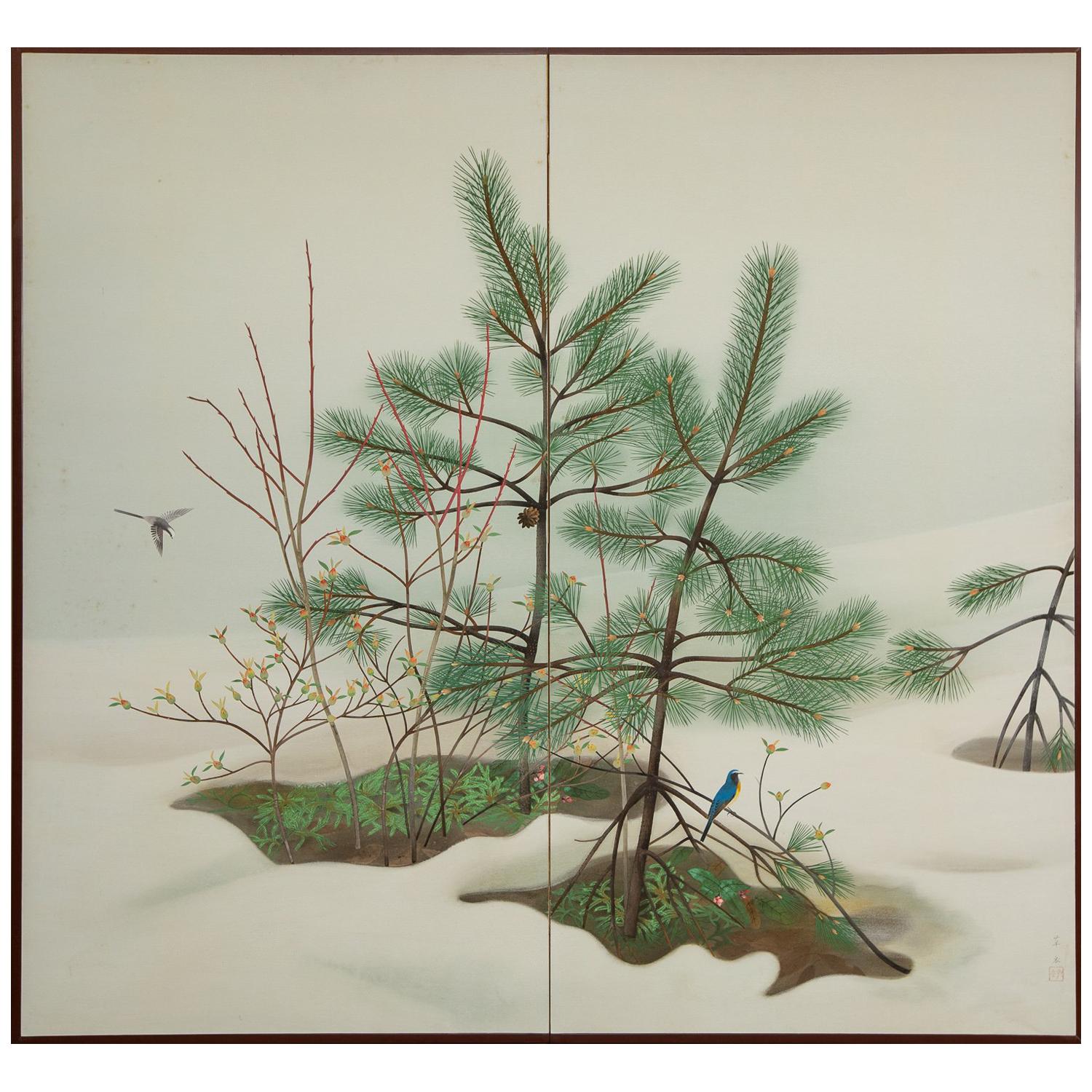Items Similar to Japanese Impressionist Painting of Trees in Snow By S Kitayama Dated 1912
Want more images or videos?
Request additional images or videos from the seller
1 of 6
Japanese Impressionist Painting of Trees in Snow By S Kitayama Dated 1912
About the Item
An impressionist painting of a trees in snow on a wooden board in period carved gilded frame.
It is signed on the bottom right hand corner S Kitayama and dated 1912.
Further inscription in Kanji on the back of the frame.
Frame measures 17 x 20 1/2 inches
Painting measures 9 1/4 x 12 3/4 inches
Frame is original to the painting and of the period.
The painter is most likely Seitaro Kitayama (Japanese, 1888-1945), an important figure in late Meiji period credited with being the father of Japanese animation before Walt Disney started his company.
The painting style is impressionism which was keenly followed by a new generation of Japanese artists who either traveled to Europe for training or received Western publications on artists and gallery shows at home.
Kitayama, Seitaro was born on March 3, 1888 in Wakayama, and died on February 13, 1945.
In 1911, Kitayama became an apprentice to Tojiro Oshita and, while studying painting, also helped out with editing the art magazine Mizue. He soon moved to Tokyo and established the Western Art Guild of Japan and published Contemporary Western Art. He later joined the Fusain Art Group as a manager where he would support young western-style artists such as Ryusei Kishida and Sohachi Kimura by providing art supplies, in addition to holding exhibitions and publishing catalogues. On the other hand, he entered the Nikkatsu Mukojima Studio in 1916, proposed the inclusion of illustrations in intertitles, and made this his work. It was there that one of the first Japanese animations, Monkey and Crabs released in May 1917 was created. Following positive reviews of his debut work, Nikkatsu continued to produce animations. Kitayama was able to create animations at the high pace of over ten films a year by forming a group production system that included individuals such as Zenjiro (Sanae) Yamamoto and Hiroshi Mineda in drawing and Kiichiro Kanai in cinematography. In 1921, Kitayama left Nikkatsu and established the independent Kitayama Eiga Seisakusho.
- Creator:Japanese Studio (Painter)
- Dimensions:Height: 17 in (43.18 cm)Width: 20.5 in (52.07 cm)Depth: 2.5 in (6.35 cm)
- Style:Modern (In the Style Of)
- Materials and Techniques:
- Place of Origin:
- Period:1910-1919
- Date of Manufacture:1912
- Condition:Minor losses.
- Seller Location:San Francisco, CA
- Reference Number:1stDibs: LU7756232006142
About the Seller
5.0
Vetted Seller
These experienced sellers undergo a comprehensive evaluation by our team of in-house experts.
1stDibs seller since 2022
- ShippingRetrieving quote...Ships From: San Francisco, CA
- Return PolicyA return for this item may be initiated within 3 days of delivery.
More From This SellerView All
- Japanese Modernist Painting of a Seaside Village by Torao Ataka Dated 1930By Japanese StudioLocated in San Francisco, CAA Modern oil painting of a harbor town with the water and mountains views in the distance. It is signed on the bottom left hand corner Ataka and dated '30 (1930). The brushwork is ...Category
Vintage 1930s Japanese Modern Paintings and Screens
MaterialsCanvas, Paint
- Japanese Expressionist Painting of a Sea View from a Balcony by Yoshio AoyamaBy Japanese StudioLocated in San Francisco, CAAn expressionist oil painting of a seaside view from a balcony in carved gilded frame. It is signed on the bottom right hand corner Aoyama. Signed Aoyama circa 1960s-1970s Frame measures 16 x 19 1/4 inches Painting measures 9 1/2 x 13 inches This painting is likely a scene from the French Riviera or Cote d'Azur. Yoshio Aoyama...Category
Late 20th Century Japanese Modern Paintings and Screens
MaterialsAcrylic, Paint
- Antique Indian Miniature Painting of Lovers Krishna & Radha, Circa 19th CenturyLocated in San Francisco, CAA charming painting of Lord Krishna and his paramour Radha painted in mineral pigments (gouache) with gold and silver highlights circa mid 19th century in Jaipur style of painting. Krishna was a god (an incarnation of god Vishnu) who accomplished great feats and defeated insurmountable demons. However, he is also considered the most playful amongst gods and an epic lover of godly proportions. His love story with Radha (a married woman) has been the subject of much poetry and worship for centuries as it symbolized the divine love. Here, the lovers are depicted in a loving embrace offering one another a lotus flower. Radha is often depicted hopelessly resisting Krishna's advances as in this painting. The couple's heads are circled by a halo, signifying their divinity. The setting is typical of the interior modeling in the 19th century with use of heavy curtains...Category
Antique Mid-19th Century Indian Paintings and Screens
MaterialsAcrylic
- Chinese Ming Dynasty Bronze Buddha of the future MaitreyaLocated in San Francisco, CAChinese Ming Dynasty period bronze figure of Bodhisattva of the future - Maitreya. It is beautifully modeled in fine details typical of high-quality casting done in the Ming dynasty ...Category
Antique 17th Century Chinese Ming Metalwork
MaterialsBronze
You May Also Like
- Japanese Meiji Period Painting by Shôjin Nishimura , Plum tree in MoonlightLocated in Amsterdam, Noord HollandVery Lovely painting.Category
Antique Mid-19th Century Japanese Meiji Paintings and Screens
MaterialsSilk
- 17th Century Japanese Framed Painting by Kano Sansetsu, Plum Blossoms in SnowLocated in Kyoto, JPKano Sansetsu (1589-1651) Plum blossoms in snow Edo period, circa 1640 Framed painting. Ink on paper. Kano Sansetsu is a Japanese painter who...Category
Antique 17th Century Japanese Edo Paintings and Screens
MaterialsPaper
- Vintage Japanese Ukiyo-e Print of Kinkaku-ji in Snow by Tokuriki TomikichiroBy Tokuriki Tomikichiro 1Located in Philadelphia, PAA fine vintage Japanese woodblock print. Entitled "Kinkaku-ji in Snow". By Tomikichiro Tokuriki (1902 - 1999). Tokuriki came from a...Category
Vintage 1960s Japanese Showa Paintings and Screens
MaterialsPaper
- Japanese Two-Panel Screen, Young Pine in SnowLocated in Hudson, NYBeautifully painted by Kido So (1899 - 1984). Born in Kyoto So studied painting at the Kyoto Municipal School of Painting under Yamamoto Shunkyo (1871...Category
Vintage 1930s Japanese Paintings and Screens
MaterialsSilk
- Japanese Two Panel Screen Bamboo in Early SnowLocated in Hudson, NYKano School painting, of the edge of a bamboo grove in early winter snow with very fine gold mist. Mineral pigments and gold dust on mulberry paper with 18th century brocade.Category
Antique 18th Century Japanese Paintings and Screens
MaterialsPaper
- Japanese Six Panel Screen: Ink Painting of a Weathered Pine TreeLocated in Hudson, NYMeiji period (1868 - 1912) sumi-e (or ink painting) on paper of a venerable pine tree with limbs stretching out over a bluff. Beautiful signature and seal read: Biei. Ink on paper ...Category
Antique 19th Century Japanese Paintings and Screens
MaterialsBrocade, Silk, Paper
Recently Viewed
View AllMore Ways To Browse
Japanese Japan
Furniture In Japan
Japanese Made
Made In Japan By
Japanese Antique Japanese
A Japanese Style
Japanese Furniture Modern
Japanese Modern
Modern Japanese
Japanese Antique Furniture
Japanese Furniture Antique
Japanned Antique Furniture
Japanese Original
Antique In Japanese
Japanese Style Furniture
Screen S
Japanese Studio
Japanese Company
